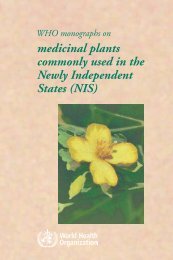Histological Typing of Thyroid Tumours - libdoc.who.int - World ...
Histological Typing of Thyroid Tumours - libdoc.who.int - World ...
Histological Typing of Thyroid Tumours - libdoc.who.int - World ...
Create successful ePaper yourself
Turn your PDF publications into a flip-book with our unique Google optimized e-Paper software.
6<br />
Among the cytological variants seen, the most importantis the follicular<br />
adenoma <strong>of</strong> oxyphilic cell type (Fig.4), which may show any <strong>of</strong> the<br />
above architectural patterns. These tumours are largely or entirely<br />
composed <strong>of</strong> eosinophilic cells, <strong>of</strong>ten with some nuclear pleomorphism<br />
and distinct nucleoli. Formerly, they were called 'Hiirthle cell'<br />
adenomas (a misnomer, since what Hiirthle described (in dogs) were<br />
probably parafollicular cells). oxyphilic cells characteristically contain<br />
large numbers <strong>of</strong> mitochondria. Very rarely, cells with apparently<br />
similar light-microscope characteristics contain increased amounts <strong>of</strong><br />
filaments, dense bodies or endoplasmic reticulum.<br />
Several other rare cytological variants are found in follicular adenomas.<br />
The clear cell type <strong>of</strong> follicular adenoma (Figs.5, 6) has to be distinguished<br />
from the clear cell variant <strong>of</strong> follicular carcinoma, parathyroid<br />
adenoma or metastasis <strong>of</strong> renal carcinoma. Immunohistological<br />
methods for staining thyroglobulin are useful for the last two purposes.<br />
The clear cells contain distended and empty-looking mitochondria<br />
and/or large amounts <strong>of</strong> glycogen.<br />
other very rare variants <strong>of</strong> follicular adenoma consist <strong>of</strong> mucinproducing<br />
cells, lipid-rich cells or so-called signet-ring cells (Figs' 7, 8)'<br />
Some follicular adenomas with norm<strong>of</strong>ollicular architecture may<br />
exhibit pseudopapillary structures which can be confused with the<br />
papillae <strong>of</strong> papillary carcinoma. A number <strong>of</strong> these hyperplastic lesions<br />
are hyperfunctioning (toxic) adenomas (Fig'11).<br />
In some adenomas cellular proliferation is more pronounced and<br />
the architectural and cytological patterns are less regular. These tumours<br />
are referred to as atypical adenomas (Figs.9, 10). In such tumours,<br />
extension through the capsule and invasion <strong>of</strong> vessels within<br />
or just outside the capsule must be carefully excluded in order to rule<br />
out the minimally invasive variant <strong>of</strong> follicular carcinoma'<br />
1.1.2 Other Adenomas<br />
Very rarely, salivary gland-type tumours may occur. Adenolipomas<br />
(Fig.12) consisting <strong>of</strong> both adipose tissue and thyroid follicular cells<br />
afe extremely rare, although small amounts <strong>of</strong> stromal adipocyte inhltration<br />
in follicular tumours are occasionally seen. Hyalinizing trabecular<br />
adenomas (Figs.13, 14) are rare, but have diagnostic importance,<br />
as they may be mis<strong>int</strong>erpreted as medullary or papillary<br />
carcinomas.
















